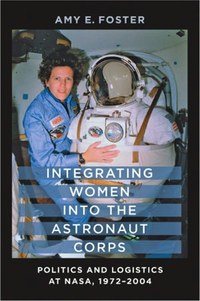Review: Integrating Women into the Astronaut Corpsby Jeff Foust
|
| While NASA might have initially been reluctant to hire female astronauts, the agency was actually more welcoming than most to women, providing them professional job opportunities difficult to come by elsewhere in the 1960s. |
While the book’s subtitle suggests its scope is limited to 1972 through 2004, Foster actually starts earlier, covering at a very high level the early history of women in military aviation as well as their portrayal in science fiction; the former since military aviation served as a major source of astronaut candidates, and the latter from the inspirational aspects of science fiction and how it served as a “classroom of ideas about women in space.” After a discussion of the so-called “Mercury 13” women who underwent medical tests as part of a privately-funded effort a half-century ago, much of the rest of the book focuses on the selection and integration of the first women selected as astronauts in 1978, comprising six of the 35 members of that class (which also included the first African-American and Asian-American astronauts) but not surprisingly receiving an outsized share of media attention.
Foster emphasizes that while NASA might have initially been reluctant to hire female astronauts, the agency was actually more welcoming than most to women, providing them professional job opportunities difficult to come by elsewhere in the 1960s. NASA administrator James Webb in 1966 issued an order calling for equal opportunities regardless of sex, going above and beyond the federal mandates of that era. Yet the agency and those pioneering women astronauts still faced many challenges, from individual mindsets slow to adapt to the changing roles of women to little details NASA hadn’t anticipated when incorporating women into the astronaut corps, like an astronaut exercise room that had only a single locker room. Foster gives particular credit to Carolyn Huntoon, a Johnson Space Center (JSC) official who served as a “mother hen” for that initial group of women astronauts and “went to the women’s defense more times than the women probably ever knew.” (Huntoon went on to become the first woman to serve as director of JSC.)
Today, Foster argues in the book’s conclusion, “NASA’s integration of women into the astronaut corps largely is complete.” As Huntoon put it, “We finally got to the point that we had hoped to get to and that was when the crew was named, the only way you would know somebody was a female was if you saw a crew picture and it was ‘Oh, yeah. There’s a woman on board.’” While Integrating Women into the Astronaut Corps is a bit pricey—a $55 list price for 160 pages, excluding endnotes, bibliography, and index—it does offer a valuable examination of something that is easy to take for granted today, at least in America.
